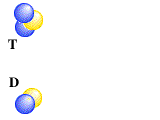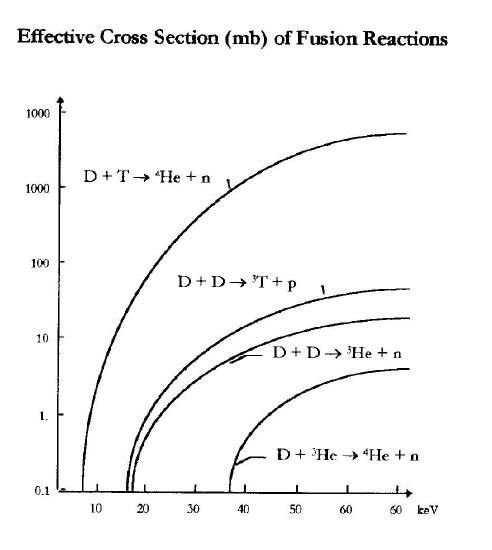Nuclear Fusion
- Page ID
- 38936
Nuclear Fusion
A large atomic nucleus splits up into two nuclei is fission. Two light atomic nuclei combine into one heavy nucleus is nuclear fusion. Fusion may release a nucleon.
 |
| From animated fusion |
Both fission and fusion generally release energy. Hydrogen fusion produces million times more energy than burning hydrogen with oxygen. Fusion reactions power stars such as the Sun. In terms of energy supply, fusion has many advantages:
- Fuel supply widely available.
- Fuel supply sufficient for millions to billions of years
- No CO2 or other emissions to cause acid rain, global warming or ozone destruction
- Much lower radioactivity hazard
- Much lower land use and environmental impact than many forms of renewable energy
To achieve nuclear fusion, two light atoms must come within a distance of 10-15 m. The strong force becomes effective at this distance, and the two nuclei unite into one nucleus.
Since atomic nuclei have positive charges, they must overcome the Coulomb potential in order to approach each other within 10-15 m. Thus, the light nuclei must be moving at high speed in their collision. Thus, nuclei are either accelerated or heated to a high temperature.
Early Fusion Research
 Particle accelerators invented for the study of nuclear reactions are also wonderful machines for the study of fusion. Accelerated H, D, T, 3He, 4He particles are used to bombard targets of these same nuclides. These experiments provide data about fusion. In particular, the following four reactions receive the most attention.
Particle accelerators invented for the study of nuclear reactions are also wonderful machines for the study of fusion. Accelerated H, D, T, 3He, 4He particles are used to bombard targets of these same nuclides. These experiments provide data about fusion. In particular, the following four reactions receive the most attention.
D + T ® 4He + n
D + 3He ® 4He + p
D + D ® 3He + n
D + D ® 3T + p
Probabilities of fusion reactions are quantitatively defined as the cross sections. Effective cross sections for various fusion reactions as functions of temperature are given here. For all four fusion reactions given above, the cross section for the reaction,
D + T ® 4He + n
is consistently the highest at any temperature. This reaction has been chosen in further fusion research, because of its potential for success.
Contributors and Attributions
Chung (Peter) Chieh (Professor Emeritus, Chemistry @ University of Waterloo)


